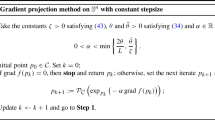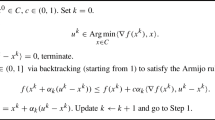Abstract
Finding the sparsest solutions to a tensor complementarity problem is generally NP-hard due to the nonconvexity and noncontinuity of the involved \(\ell _0\) norm. In this paper, a special type of tensor complementarity problems with Z-tensors has been considered. Under some mild conditions, we show that to pursuit the sparsest solutions is equivalent to solving polynomial programming with a linear objective function. The involved conditions guarantee the desired exact relaxation and also allow to achieve a global optimal solution to the relaxed nonconvex polynomial programming problem. Particularly, in comparison to existing exact relaxation conditions, such as RIP-type ones, our proposed conditions are easy to verify.
Similar content being viewed by others
Notes
More precisely, here the tensor should be called the hypermatrix. In physics and mechanics, tensors are geometric objects equipped with a transformation law that details how the components of the tensor respond to a change of basis, while hypermatrices are simply multi-dimensional arrays. However, for most papers in tensor decomposition (e.g., the survey paper [25] in SIAM Review, and the numerical optimization methods in [24] in Math. Programming), and in tensor complementarity problems (e.g., [34]), the word “tensors” is used for multi-dimensional arrays. We will then roughly use the word “tensors” throughout this paper.
References
Amann, H.: Fixed point equations and nonlinear eigenvalue problems in ordered banach spaces. SIAM Rev. 18(4), 620–709 (1976)
Blumensath, T.: Compressed sensing with nonlinear observations and related nonlinear optimization problems. IEEE Trans. Inf. Theory 59(6), 3466–3474 (2013)
Candes, E.J.: The restricted isometry property and its implications for compressed sensing. Comptes Rendus Math. 346(9), 589–592 (2008)
Candes, E.J., Romberg, J.K., Tao, T.: Stable signal recovery from incomplete and inaccurate measurements. Commun. Pure Appl. Math. 59(8), 1207–1223 (2006)
Candes, E.J., Tao, T.: Decoding by linear programming. IEEE Trans. Inf. Theory 51(12), 4203–4215 (2005)
Candes, E.J., Wakin, M.B., Boyd, S.P.: Enhancing sparsity by reweighted \(\ell _1\) minimization. J. Fourier Anal. Appl. 14(5–6), 877–905 (2008)
Che,M., Qi,L., Wei,Y.: Positive definite tensors to nonlinear complementarity problems. J Optim Theory Appl. 168, 475–487 (2016)
Chen, X., Ge, D., Wang, Z., Ye, Y.: Complexity of unconstrained \(l_2-l_p\) minimization. Math. Program. 143(1–2), 371–383 (2014)
Chen, X., Ng, M.K., Zhang, C.: Non-Lipschitz-regularization and box constrained model for image restoration. IEEE Trans. Image Process. 21(12), 4709–4721 (2012)
Chen, X., Xiang, S.: Sparse solutions of linear complementarity problems. Preprint (2014)
Comon, P., Golub, G., Lim, L.H., Mourrain, B.: Symmetric tensors and symmetric tensor rank. SIAM J. Matrix Anal. Appl. 30(3), 1254–1279 (2008)
De Lathauwer, L., De Moor, B., Vandewalle, J.: On the best rank-1 and rank-\((R_1, R_2,\cdots , R_N)\) approximation of higher-order tensors. SIAM J. Matrix Anal. Appl. 21(4), 1324–1342 (electronic) (2000)
Ding, W., Qi, L., Wei, Y.: \(M\)-tensors and nonsingular \(M\)-tensors. Linear Algebra Appl. 439(10), 3264–3278 (2013)
Ding, W., Wei, Y.: Solving multi-linear systems with \(\cal M\)-tensors. Preprint (2015)
Donoho, D.L.: Compressed sensing. IEEE Trans. Inf. Theory 52(4), 1289–1306 (2006)
Donoho, D.L., Tanner, J.: Precise undersampling theorems. Proc. IEEE 98(6), 913–924 (2010)
Facchinei, F., Pang, J.S.: Finite-dimensional Variational Inequalities and Complementarity Problems. Springer Series in Operations Research, vol. I. Springer-Verlag, New York (2003)
Foucart, S., Lai, M.J.: Sparsest solutions of underdetermined linear systems via \(l_q\)-minimization for \(0<q\le 1\). Appl. Comput. Harmon. Anal. 26(3), 395–407 (2009)
Gowda, M.S., Luo, Z., Qi, L., Xiu, N.: \(Z\)-tensors and complementarity problems. arXiv preprint arXiv:1510.07933 (2015)
Harmany, Z.T., Marcia, R.F., Willett, R.M.: Spiral out of convexity: sparsity-regularized algorithms for photon-limited imaging. In: IS&T/SPIE Electronic Imaging, pp. 75330R–75330R. International Society for Optics and Photonics (2010)
Isac, G.: Complementarity problems. Springer-Verlag, Berlin (1992)
Juditsky, A., Nemirovski, A.: On verifiable sufficient conditions for sparse signal recovery via \(\ell _1\) minimization. Math. Program. 127(1), 57–88 (2011)
Khajehnejad, M.A., Dimakis, A.G., Xu, W., Hassibi, B.: Sparse recovery of nonnegative signals with minimal expansion. IEEE Trans. Signal Process. 59(1), 196–208 (2011)
Kolda, T.G.: Numerical optimization for symmetric tensor decomposition. Math. Program. 151(1), 225–248 (2015)
Kolda, T.G., Bader, B.W.: Tensor decompositions and applications. SIAM Rev. 51(3), 455–500 (2009)
Lauer, F., Ohlsson, H.: Finding sparse solutions of systems of polynomial equations via group-sparsity optimization. J. Glob. Optim. 62(2), 319–349 (2015)
Li, X., Voroninski, V.: Sparse signal recovery from quadratic measurements via convex programming. SIAM J. Math. Anal. 45(5), 3019–3033 (2013)
Liu, Y.F., Dai, Y.H., Luo, Z.Q.: Joint power and admission control via linear programming deflation. IEEE Trans. Signal Process. 61(6), 1327–1338 (2013)
Luo, Z., Qin, L., Kong, L., Xiu, N.: The nonnegative zero-norm minimization under generalized \(Z\)-matrix measurement. J. Optim. Theory Appl. 160(3), 854–864 (2014)
Qi, L.: Eigenvalues of a real supersymmetric tensor. J. Symb. Comput. 40(6), 1302–1324 (2005)
Rheinboldt, W.C.: On \(M\)-functions and their application to nonlinear Gauss–Seidel iterations and to network flows. J. Math. Anal. Appl. 32, 274–307 (1970)
Shang, M., Zhang, C., Xiu, N.: Minimal zero norm solutions of linear complementarity problems. J. Optim. Theory Appl. 163(3), 795–814 (2014)
Sheikh, M.A., Sarvotham, S., Milenkovic, O., Baraniuk, R.G.: Dna array decoding from nonlinear measurements by belief propagation. In: IEEE/SP 14th Workshop on statistical signal processing, 2007. SSP’07, pp. 215–219. IEEE (2007)
Song, Y., Qi, L.: Properties of some classes of structured tensors. J. Optim. Theory Appl. 165(3), 854–873 (2014)
Song, Y., Qi, L.: Properties of tensor complementarity problem and some classes of structured tensors. arXiv preprint arXiv:1412.0113 (2014)
Tamir, A.: Minimality and complementarity properties associated with \(Z\)-functions and \(M\)-functions. Math. Program. 7, 17–31 (1974)
Xu, Z., Chang, X., Xu, F., Zhang, H.: regularization: a thresholding representation theory and a fast solver. IEEE Trans. Neural Netw. Learn. Syst. 23(7), 1013–1027 (2012)
Yang, Y., Yang, Q.: Further results for Perron–Frobenius theorem for nonnegative tensors. SIAM J. Matrix Anal. Appl. 31(5), 2517–2530 (2010)
Zhang, L., Qi, L., Zhou, G.: \(M\)-tensors and some applications. SIAM J. Matrix Anal. Appl. 35(2), 437–452 (2014)
Zhang, Y.: Theory of compressive sensing via \(\ell _1\)-minimization: a non-RIP analysis and extensions. J. Oper. Res. Soc. China 1(1), 79–105 (2013)
Zhao, Y.B.: RSP-based analysis for sparsest and least \(\ell _1\)-norm solutions to underdetermined linear systems. IEEE Trans. Signal Process. 61(22), 5777–5788 (2013)
Acknowledgments
The authors would like to thank two anonymous referees and the associated editor for their valuable comments, and Mr. Weiyang Ding and Prof. Wei for the proof of Proposition 3 and their matlab codes of the Gauss-Seidel iteration method.
Author information
Authors and Affiliations
Corresponding author
Additional information
This research was supported by the National Natural Science Foundation of China (11301022, 11431002), the State Key Laboratory of Rail Traffic Control and Safety, Beijing Jiaotong University (RCS2014ZT20, RCS2014ZZ01), and the Hong Kong Research Grant Council (Grant No. PolyU 502111, 501212, 501913 and 15302114).
Rights and permissions
About this article
Cite this article
Luo, Z., Qi, L. & Xiu, N. The sparsest solutions to Z-tensor complementarity problems. Optim Lett 11, 471–482 (2017). https://doi.org/10.1007/s11590-016-1013-9
Received:
Accepted:
Published:
Issue Date:
DOI: https://doi.org/10.1007/s11590-016-1013-9




